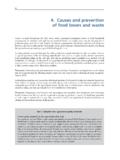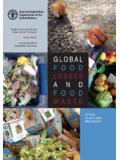Transcription of Global Plastic Production Rises, Recycling Lags
1 1 Global Plastic Production Rises, Recycling Lags Gaelle Gourmelon | January 27, 2015 or more than 50 years, Global Production of Plastic has continued to Some 299 million tons of plastics were produced in 2013, representing a percent increase over 2012's With a market driven by consumerism and convenience, along with the comparatively low price of Plastic materials, demand for Plastic is Recovery and Recycling , however, remain insufficient, and millions of tons of plastics end up in landfills and oceans each plastics are human-made materials manufactured from polymers, or long chains of repeating They are derived from oil, natural gas, and while still a small portion of overall Production increasingly, from plants like corn and About 4 percent of the world s petroleum is used to make Plastic , and another 4 percent is used to power Plastic manufacturing First invented in the 1860s but developed for industry in the 1920s, Plastic Production exploded in the 1940s, becoming one of the fastest-growing Global From 1950 to 2012, plastics growth averaged percent per year, booming from million tons to the nearly 300 million tons of Worldwide Production continued to grow between the 1970s and 2012 as plastics gradually replaced materials like glass and Metal, glass, and paper are increasingly replaced by Plastic packaging, particularly for foods.
2 By 2009, Plastic packaging accounted for 30 percent of packaging With the push by federal mileage standards to reduce the weight of vehicles, the American automobile industry has been a champion of this transition too. plastics make up about 10 percent by weight (50 percent by volume) of a typical vehicle today, representing 336 pounds of Plastic per In 1960, less than 20 pounds of Plastic were used in plastics now often replace metals in bumpers and door panels as well as in engine components. Today the Global Plastic industry generates revenue of about $600 billion plastics are found throughout many sectors and industries, including transportation, construction, health care, food products, telecommunications, and consumer Per capita Plastic consumption reached 100 kilograms (kg) in Western Europe and North Asia currently uses just 20 kg per person, but this figure is expected to grow plastics Production is also shifting toward Asia.
3 The region produced percent of Global plastics in 2013, with China alone producing nearly a quarter of the world s (See Figure 1.) China surpassed Europe in plastics Production in India has recently seen strong growth in Plastic Production due to an increasing population and the growth of manufacturing sectors in the Today, Europe and the states emerging from the former Soviet Union account for percent of Global Plastic Production , with Germany leading European Production . North America, led in large part by the United States, F The Global Plastic industry generates revenue of about $600 billion annually 2 produces percent of Global The Middle East and Africa ( percent) and Central and South America ( percent) have the smallest Global shares of Packaging is responsible for the majority of Plastic use, representing 40 percent of demand in Europe and 42 percent in the United (See Figure 2.) Consumer and household products (like appliances, toys, Plastic cutlery, and furniture) account for the next most significant segment, closely followed by the building and construction Within the United States, the largest consuming industries are construction (which uses Plastic products like pipes, window and door frames, roofing, and siding) and the food and beverage industry (which uses products like Plastic bottles, containers, and film).
4 25 Between 22 and 43 percent of Plastic worldwide is disposed of in landfills, where its resources are wasted, it takes up valuable space, and it blights Recovering Plastic from the waste stream for Recycling or for energy has the potential to minimize these However, much of the plastics collected for Recycling is shipped to countries with lower environmental standards, making the balance between environmental protection, clean material cycles, and resource use unstable. Further, energy recovery from plastics is often inefficient, requires air emissions controls, and produces hazardous Actual rates of recovery vary widely across countries. In Europe, 26 percent, or million tons, of post-consumer Plastic produced in 2012 was recycled, while 36 percent was incinerated for energy This means that 38 percent of post-consumer 22-43% of Plastic worldwide is disposed of in landfills 3 In the United States, only 9% of Plastic was recycled in 2012 plastics in Europe went to This represents a 26 percent decrease in plastics ending up this way compared with 2006, but nearly half of all European countries still send the majority of their Plastic waste to Nine European countries Austria, Belgium, Denmark, Germany, Luxembourg, Netherlands, Norway, Sweden, and Switzerland have enacted landfill bans for While these countries do generally achieve higher Recycling rates than countries with no landfill bans, a majority of Plastic is disposed of through incineration for energy In the United States, only 9 percent of Plastic ( million tons)
5 Was recycled in The remaining 32 million tons were discarded, accounting for nearly 13 percent of the nation s municipal solid waste The United States depends mostly on China and Hong Kong to absorb its Plastic waste, although some is sent to Canada and In other parts of the world, recovery of plastics is even lower. The United Nations Environment Programme estimates that 57 percent of Plastic in Africa, 40 percent in Asia, and 32 percent in Latin America is not even collected, being instead littered or burned in the The largest waste plastics exporters are the United States, followed by Japan, Germany, and the United Europe exports about half of the plastics it collects for Recycling and is the largest Global exporter of waste Plastic intended for 4 China receives 56% of waste Plastic imports worldwide Most Plastic scraps from western countries with established collection systems flow to China, which receives 56 percent (by weight)
6 Of waste Plastic imports What happens to all this imported Plastic once it gets there is not well understood, The International Solid Waste Association reports that indirect evidence suggests the majority of Plastic is still being reprocessed using family-run, low-tech businesses with no environmental protection There are also concerns that low-quality plastics are not reused but are disposed of or incinerated for energy recovery in plants without air pollution control Through its 2010 Green Fence Operation, the Chinese government has started to work to reduce unregulated Europe depends on China for 87 percent of its Plastic waste exports intended for This leaves the Global plastics Recycling market highly vulnerable to market changes in China, as was shown by recent quality control implementations by China s customs (implementing a zero tolerance policy for contamination levels in imports), which resulted in a crash in the price of secondary raw Approximately 10 20 million tons of Plastic end up in the oceans each Including financial losses by fisheries and tourism as well as time spent cleaning beaches, $13 billion a year is lost in environmental damage by plastics to marine Marine wildlife is particularly vulnerable to Plastic Animals such as seabirds, whales, and dolphins can become entangled in Plastic Floating plastics like discarded nets, docks, and boats transport microbes, algae, invertebrates, and fish into non-native Once in the ocean, Plastic does not go away.
7 It breaks down into small pieces that are ingested by sea life and transferred up the food chain, carrying chemical pollutants from prey to A recent study conservatively estimated that trillion Plastic particles weighing 268,940 tons are currently floating in the world s oceans. 53 Because plastics are moved with wind and currents, very few areas in the ocean may have escaped Plastic The North Pacific gyre contains the most, with nearly 2 trillion pieces of Plastic weighing over 96,000 (See Figure 3.) In the southern hemisphere, the Indian Ocean has more Plastic pollution than the South Pacific and South Atlantic combined The environmental and social benefits of plastics must be weighed against the problems that its durability and incredible volume worldwide constitute as a waste plastics help to reduce food waste by keeping products fresh longer, allow for the manufacture of health care equipment, reduce packaging mass compared with other materials, improve transportation efficiency, and have large potential for renewable energy But Plastic litter, gyres of plastics in the oceans, and toxic additives in Plastic products such as colorings, flame retardants, and plasticizers are raising awareness and strengthening consumer demand for more-sustainable Along with reducing unnecessary Plastic consumption, finding more environmentally friendly packaging alternatives.
8 And improving product and packaging design to use less Plastic , many challenges associated with plastics could be addressed by improving management of the material across its Businesses and consumers could increase their participation in collection in order to move Plastic waste toward a Recycling or recovery supply chain. Companies could switch to recycled plastics , using joint ventures to ensure They could also investigate options for using bioplastics plastics that are partly or fully biobased, biodegradable, or both although the benefits Approximately 10-20 million tons of Plastic ends up in the oceans each year 5 and impacts of these products are currently Governments must regulate the Plastic supply chain to encourage Recycling , and consortia must coordinate and monitor the supply chain and provide guidelines for Plastic waste processing, especially in developing As the economy and population grow, Global demand for Plastic is expected to continue to grow especially in Africa, Latin America, the Middle East, and Immediate action is needed to handle today's and tomorrow s Plastic problem.
9 Gaelle Gourmelon is the Communications and Marketing Manager at the Worldwatch Institute. Vital Signs Online provides business leaders, policymakers, and engaged citizens with the latest data and analysis they need to understand critical Global trends. Subscribe now for full access to hard data and research-based insights on the sustainability trends that are shaping our future. Worldwatch Institute 1400 16th St., NW, Suite 430 Washington, DC 20036 Phone: 6 Global Plastic Production Rises, Recycling Lags 1 PlasticsEurope, plastics The Facts 2014: An Analysis of European plastics Production , Demand and Waste Data (Brussels: 2014). 2 Ibid. 3 Environment Programme (UNEP), Valuing plastics : The Business Case for Measuring, Managing and Disclosing Plastic Use in the Consumer Goods Industry (Nairobi: 2014). 4 Ibid. 5 Germany Trade & Invest, Industry Overview: The plastics Industry in Germany (Berlin: 2014); PlasticsEurope, op.
10 Cit. note 1; American Chemistry Council, Economics and Statistics Department, Plastic Resins in the United States (Washington, DC: 2013). 6 American Chemistry Council, op. cit. note 5. 7 The European House Ambrosetti, The Excellence of the plastics Supply Chain in Relaunching Manufacturing in Italy and Europe (Milan: 2013); UNEP, op. cit. note 3. 8 American Chemistry Council, op. cit. note 5. 9 PlasticsEurope, op. cit. note 1; European House Ambrosetti, op. cit. note 7. 10 American Chemistry Council, op. cit. note 5. 11 World Packaging Organization, Market Statistics and Future Trends in Global Packaging (Naperville, IL: 2009). 12 American Chemistry Council, Economics and Statistics Department, plastics and Polymer Composites in Light Vehicles (Washington, DC: 2014). 13 Ibid. 14 First Research, Plastic Resin & Synthetic Fiber Manufacturing Industry Profile (Austin, TX: 2014). 15 European House Ambrosetti, op. cit. note 7. 16 Germany Trade & Invest, op.





